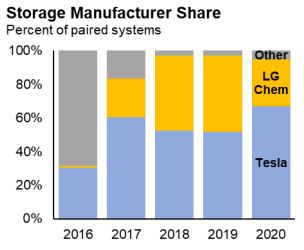From pv magazine International
In Parts 1 and 2 of this series, pv magazine reviewed the productive lifespan of residential solar panels and inverters. Here, we examine home batteries, how well they perform over time, and how long they last.
Residential energy storage has become an increasingly popular feature of home solar. A recent SunPower survey of more than 1,500 households showed that about 40% of Americans worry about power outages on a regular basis. Of the survey respondents who are actively considering solar for their homes, 70% said they plan to include a battery energy storage system.
Besides providing backup power during outages, many batteries are integrated with technology that allows for intelligent scheduling of the import and export of energy. The idea here is to maximize the value of the home’s solar system. And some batteries are optimized to integrate an electric vehicle charger.

Although deployment of energy storage is on a steady climb, attachment rates of batteries remain low. In 2020, just 8.1% of residential solar systems included attached batteries, according to Lawrence Berkeley National Laboratory (LBL).
Many options exist with multiple battery chemistries available for home energy storage. The bottom line, however, is that in the United States, two brands dominate the space. More than 90% of the market is served by LG Chem and Tesla Powerwall, which are lithium-ion batteries, according to LBL. Tesla controls more than 60% of the entire market.
The Tesla PowerWall has a limited warranty that says the device will be free from defects for 10 years following installation. It also warrants that the PowerWall will start its life with a capacity of 13.5 kWh, and will retain energy capacity based on a degradation schedule.
LG claims that its system will retain at least 60% of its nominal energy capacity (9.8 kWh) for 10 years. The battery must operate between -10 C and 45 C to remain covered by the warranty. Total throughput of energy within the warranty is limited to 27.4 MWh.
Battery life
Solar installer Sunrun said batteries can last anywhere between five to 15 years. That means a replacement likely will be needed during the 20 to 30 year life of a solar system.
Battery life expectancy is mostly driven by usage cycles. As demonstrated by the LG and Tesla product warranties, thresholds of 60% or 70% capacity are warranted through a certain number of charge cycles.

Inverter Image: LG Chem
Two use-scenarios drive this degradation: overcharge and trickle charge, said the Faraday Institute. Overcharge is the act of pushing current into a battery that is fully charged. Doing this can cause it to overheat, or even potentially catch fire.
Trickle charge involves a process in which the battery is continually charged up to 100%, and inevitably losses take place. The bounce between 100% and just under 100% can elevate internal temperatures, diminishing capacity and lifetime.
Another cause of degradation over time is the loss of mobile lithium-ions in the battery, said Faraday. Side reactions in the battery can trap free usable lithium, thereby lowering capacity gradually.
While cold temperatures can halt a lithium-ion battery from performing, they do not actually degrade the battery or shorten its effective life. Overall battery lifetime is, however, diminished at high temperatures, said the Faraday Institute. This is because the electrolyte that sits between the electrodes breaks down at elevated temperatures, causing the battery to lose its capacity for Li-ion shuttling. This can reduce the number of Li-ions the electrode can accept into its structure, depleting the lithium-ion battery capacity.
Maintenance matters
It is recommended by the National Renewable Energy Laboratory (NREL) to install a battery in a cool, dry place, preferably a garage, where the impact of a fire (a small, but potential threat) can be minimized. Batteries and components around them should have proper spacing to allow cooling, and regular maintenance check-ups can be helpful in ensuring optimal operation.

NREL said that whenever possible, avoid repeated deep discharging of batteries, as the more it is discharged, the shorter the lifetime. If the home battery is discharged deeply every day, it may be time to increase the battery bank’s size.
Batteries in series should be kept at the same charge, said NREL. Though the entire battery bank may display an overall charge of 24 volts, there can be varied voltage among the batteries, which is less beneficial to protecting the entire system over the long run. Additionally, NREL recommended that the correct voltage set points are set for chargers and charge controllers, as determined by the manufacturer.
Inspections should occur frequently, too, said NREL. Some things to look for include leakage (build-up on the outside of the battery), appropriate fluid levels, and equal voltage. NREL said each battery manufacturer may have additional recommendations, so checking maintenance and data sheets on a battery is a best practice.
This content is protected by copyright and may not be reused. If you want to cooperate with us and would like to reuse some of our content, please contact: editors@pv-magazine.com.









By submitting this form you agree to pv magazine using your data for the purposes of publishing your comment.
Your personal data will only be disclosed or otherwise transmitted to third parties for the purposes of spam filtering or if this is necessary for technical maintenance of the website. Any other transfer to third parties will not take place unless this is justified on the basis of applicable data protection regulations or if pv magazine is legally obliged to do so.
You may revoke this consent at any time with effect for the future, in which case your personal data will be deleted immediately. Otherwise, your data will be deleted if pv magazine has processed your request or the purpose of data storage is fulfilled.
Further information on data privacy can be found in our Data Protection Policy.